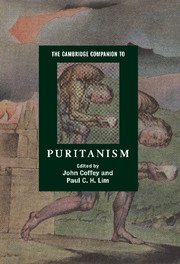Book contents
- Frontmatter
- Introduction
- Part I: English Puritanism
- Part II: Beyond England
- Part III: Major Themes
- 11 Practical divinity and spirituality
- 12 Puritan polemical divinity and doctrinal controversy
- 13 Puritans and the Church of England: historiography and ecclesiology
- 14 Radical Puritanism, c. 1558-1660
- 15 Puritan millenarianism in old and New England
- 16 The godly and popular culture
- 17 Puritanism and gender
- 18 Puritanism and literature
- Part IV: Puritanism and posterity
- Index
13 - Puritans and the Church of England: historiography and ecclesiology
from Part III: - Major Themes
Published online by Cambridge University Press: 28 November 2008
- Frontmatter
- Introduction
- Part I: English Puritanism
- Part II: Beyond England
- Part III: Major Themes
- 11 Practical divinity and spirituality
- 12 Puritan polemical divinity and doctrinal controversy
- 13 Puritans and the Church of England: historiography and ecclesiology
- 14 Radical Puritanism, c. 1558-1660
- 15 Puritan millenarianism in old and New England
- 16 The godly and popular culture
- 17 Puritanism and gender
- 18 Puritanism and literature
- Part IV: Puritanism and posterity
- Index
Summary
Patrick Collinson, in The Religion of Protestants, discusses the divergent streams within English Protestantism, emphasising the role of episcopacy in the nation's politics of religion since the Reformation was brought to the English by Henry VIII's royal injunction: “They almost oblige us declare our preferences for one of two alternative episcopal strategies and, among historians . . . we must line up either with Richard Baxter, who wrote of the Elizabethan Archbishop Grindal, the soul of protestant moderation: 'Such bishops would have prevented our contentions and wars'; or with Clarendon, for whom the . . . death of . . . Archbishop Bancroft in 1610 was one of the earliest events to which it was profitable to refer in accounting for the Great Rebellion - 'with whom died', wrote Heylyn of Bancroft, 'the Uniformity of the Church of England'.” What is fascinating is that both Baxter and Heylyn are cited as representatives of two opposing historiographical trends concerning seventeenth-century England, both then and even now. The common question facing Heylyn and Baxter was: who stood for the true Church of England? Inherent in this question were conflicting versions of ecclesiological definition, setting at odds former co-religionists who shared episcopal ordinations, zeal against separatismand radicalism, and the vision of a godly nation at prayer.
- Type
- Chapter
- Information
- The Cambridge Companion to Puritanism , pp. 223 - 240Publisher: Cambridge University PressPrint publication year: 2008
- 1
- Cited by



